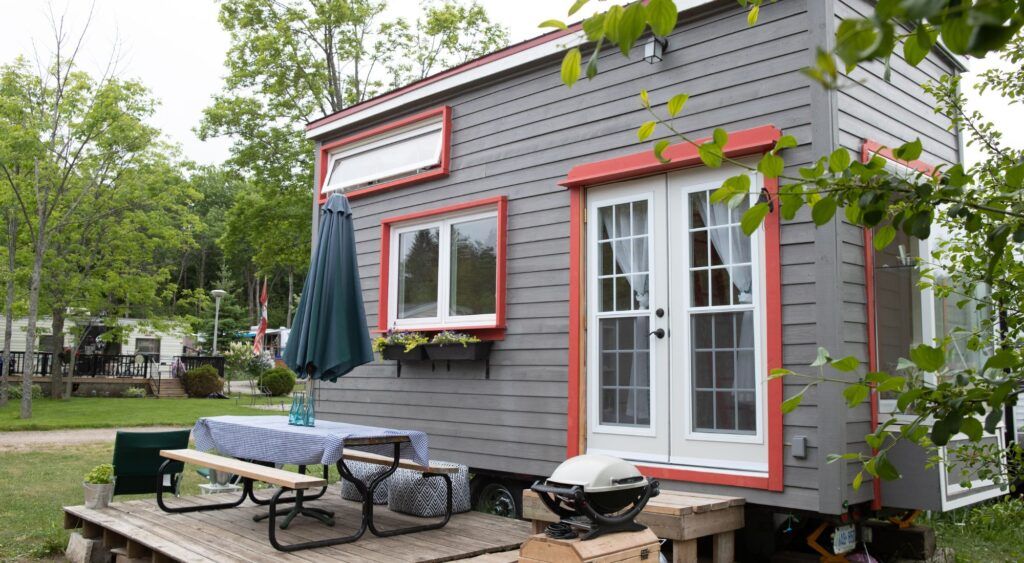Living in hotels is getting old fast. You’ve considered short-term rentals for your longer travel nursing contracts, but you’re tired of packing up your home every 13 weeks.
An RV has crossed your mind — but they’re not exactly something you consider “home.”
And you don’t necessarily love the idea of paying a mortgage on a big home you’re rarely in.
Could a tiny home be a good option for a travel nurse? After all, you can put it on wheels and keep the feeling of home with you on every assignment.
While there are benefits to purchasing a tiny home, there are also some drawbacks. Follow along as we touch on these topics and more to help you decide if purchasing a tiny home as a travel nurse is a good idea.
Table of Contents
- Distinguishing the Difference Between Tiny Homes & RVs
- 5 Advantages of Living in a Tiny House as a Travel Nurse
- 3 Disadvantages of Travel Nursing With a Tiny House
- RV vs. Tiny House: Which Is Better for a Travel Nurse?
- Find Your ‘Home Away From Home’ on Every Assignment When You Work With Trusted Nurse Staffing
Distinguishing the Difference Between Tiny Homes & RVs
Tiny homes and RVs (recreational vehicles) are similar in that they are both small, compact living spaces — but they are designed for different purposes and have distinct differences.
Tiny homes are typically built on a permanent foundation and are designed to be stationary, while RVs are built on a chassis and are meant to be mobile. Tiny homes are also usually constructed to be more energy-efficient and sustainable and are often customized to the owner’s specific needs and preferences.
RVs, on the other hand, are generally manufactured and sold by companies and are designed for travel and temporary living. They usually have their own built-in utility systems.
Another difference between tiny homes and RVs is that tiny homes may be considered a form of alternative housing and may not be subject to the same regulations as traditional homes or RVs.
RVs are regulated by every state’s Department of Transportation and must meet certain safety standards.
Are There Different Types of Tiny Houses?
Yes, there are many types of tiny houses, and the right type for you as a travel nurse will depend on your unique needs.
Some of the most common types of tiny houses include:
- Traditional tiny houses: These are small, stationary homes that are typically built on a permanent foundation. They can be customized to your unique preferences and needs. These are generally the most energy-efficient and sustainable tiny homes — making them so popular for people looking to live in one location.
Purchasing a traditional tiny house as a travel nurse may be ideal if you’re looking for a small home to return to between contracts, not necessarily to travel with.
- Tiny houses on wheels (THOWs): A tiny house on wheels, also known as a THOW, is a small home that is built on a trailer chassis, making it mobile. The design of these homes makes them easily transportable.
Because THOWs can be parked in various locations, like RV parks, campgrounds, or private land, they may be an ideal choice for a travel nurse who wants to take their homes to their travel nursing assignments.
- Container tiny houses: Container tiny homes are built using shipping containers. They are typically considered a more eco-friendly option and are known for their strength and durability.
While they are generally a top choice for homeowners looking for lower construction and maintenance costs, taking a container home with you on assignment as a travel nurse may be a bit difficult.
- Skoolies: Skoolies are tiny houses built on a school bus chassis. These homes are often created by converting an old school bus into a livable space. Skoolies are perfect for the nomadic lifestyle of travel nurses.
If you are a travel nurse looking for a tiny house but want something easy to maintain, easy to transport, and don’t mind smaller spaces, a skoolie, which already has a built-in engine, may be the ideal option.

5 Advantages of Living in a Tiny House as a Travel Nurse
#1: Save Money On Assignment
While the initial investment in a tiny home may feel like a lot — and it can be — when you’re travel nursing in a tiny home you may find that you actually save money.
Parking your tiny home may cost you, on average, $300 – $800 per month. The median monthly rent costs in the U.S. have surpassed $2,000 per month — and that doesn’t count utilities.
Even a hotel, which may seem cheaper initially, gets costly. You may have a small kitchenette — if you’re lucky — but you’ll have little room to store food and essentials, so, you may find yourself spending money on groceries more frequently.
Living in a tiny home as a travel nurse allows you to get cooking. When you aren’t staying in a hotel, you have the ability to cook meals and store your food — no more relying on take-out or hotel breakfasts.
Those stipends can be put to great use when you’re saving money on housing and meals.
#2: You Can Stop Unpacking & Repacking During Every Assignment
Say “so long” to the days of living out of suitcases. When you choose to take a tiny home with you on assignment, your whole wardrobe can come along with you. You can even bring your most prized possessions if that makes you more comfortable when you’re traveling.
When you bring your own home with you, you’ll always be unpacked.
Not only can this save you time preparing for each travel nursing assignment, but it can also eliminate the stress of deciding what you’ll bring with you and what you’ll leave behind.
Instead of spending your time off packing and unpacking your suitcases, you can spend more time making friends, exploring cities, or simply relaxing in your home.
#3: Tiny Houses Are More Eco-Friendly
If you’re searching for housing that’s easy on your wallet and environmentally friendly, purchasing a tiny house as a travel nurse may be the right choice for you.
Because tiny homes require fewer materials and smaller appliances, your carbon footprint can be less than an eighth as much of a normal home.
Many tiny homes are built with more sustainable building materials. They may be built out of reclaimed wood, bamboo, cork, or, as mentioned above, metal shipping containers.
Because of their smaller kitchen, bathroom, and laundry areas, you generally use less water when you live in a tiny home. Plumbing features, like your shower heads and toilets, generally are more efficient and can help conserve water.
But the benefits don’t stop there.
As a travel nurse, you likely already understand the need to reduce clutter.
When you live in a tiny home, the square footage is much smaller than a house and most apartments, meaning you don’t have the opportunity to accumulate as much clutter or produce as much waste.
#4: Less Cleaning, More Adventure
The inability to live in overwhelming amounts of clutter can also be beneficial for your life off the clock.
Spend your time off enjoying the cities and spaces your travel nursing assignments are in. Instead of spending hours cleaning and organizing your belongings and living spaces, you’ll be able to quickly clean and go!
At Trusted Nurse Staffing, we also understand your need for adventure.
This is why we support your desire to do what else you love outside of nursing. We believe in providing flexibility and want you to be able to enjoy the things you’re passionate about — like exploring the country!
#5: Pet-Lovers Can Enjoy Hassle-Free Traveling
Being a travel nurse makes having pets a bit more challenging. Finding a place that …
- Allows pets
- Doesn’t charge astronomical pet fees for short stays
- Has enough room for your pet to roam
… can be pretty tricky. You could leave your pets in the care of someone else during your assignments — but that can get costly, and it’s not necessarily fair to you or your pets.
Although tiny homes may not have as much room as you might like for a large pet — though you can park somewhere with lots of running space — they are perfect for travel nurses with small pets.
Tiny homes offer pets the comfort of living in “their” space no matter where you’re traveling to.

3 Disadvantages of Travel Nursing With a Tiny House
#1: Finding the Right Location To Park Can Prove Challenging
This is where things may get tricky as a travel nurse. While hotels, apartments, condos, and houses aren’t necessarily hard to find near your assignment, finding a place to park may be.
Bringing your home with you alleviates the need to find housing directly, but you still need to figure out where you will be able to park your tiny home while working your assignment.
Travel nurses living in tiny houses while on assignment may be able to park at:
- RV Parks
- Campgrounds
- State parks
- National parks
- Privately owned land being rented out
When searching for where to park your tiny house, you’ll want to consider how far away the location is from your hospital or clinic. Things to consider include:
- How much time will it take to get to work each day?
- Is there heavy traffic?
- Will the cost of gas be worth the daily commute?
#2: Relocating a Tiny Home Can Be Stressful
Although they are “tiny,” relocating tiny homes can still be challenging for more reasons than one.
When considering purchasing a tiny home for travel nurse assignments, you may want to consider the following relocation issues you could face:
- Zoning and building codes: Local governments all have different — and potentially strict — zoning and building codes. This can make it difficult to find a location to legally place your tiny home near your assignment.
- Transportation: Although tiny houses can be built on wheels, they can be difficult to transport due to their size and weight. Tiny houses generally aren’t built with aerodynamics in mind and aren’t necessarily designed to be regularly driven or towed.
- Road restrictions: Some states and municipalities have various weight, width, and height restrictions for vehicles on the road, making it difficult for tiny houses to be transported long distances.
#3: Insurance Issues May Arise
Another issue travel nurses may have to overcome when choosing to live in a tiny house on assignment is finding the right insurance for their homes.
Travel nurses may find that when insuring their tiny home, they:
- Have limited options
- Are paying higher premiums for tiny homes on wheels
- Must deal with strict underwriting processes for coverage

RV vs. Tiny House: Which Is Better for a Travel Nurse?
As a travel nurse, deciding between an RV vs. a tiny house involves evaluating your needs.
Are you looking for a living space you can easily take with you from assignment to assignment? Or does making your “home away from home” feel more like home? Are aesthetics important to you?
While RVs tend to do better for the actual traveling part of the job, tiny houses may offer more space and comfort than an RV while on assignment.
Find Your ‘Home Away From Home’ on Every Assignment When You Work With Trusted Nurse Staffing
While we can’t tell you whether you should choose a tiny home, RV, or more traditional way of living on assignment, we can tell you that when you work with Trusted Nurse Staffing, you’re surrounded by support and encouragement.
With Trusted Nurse Staffing’s team on your side, you’ll be able to:
- Connect with other nurses
- Choose from company housing options
- Receive stipends to cover housing, meals, and travel
- Select from a variety of flexible contracts
- And more
Don’t put your dreams of exploration, flexibility, and balance in your nursing career on hold any longer. Contact us today to join our team of travel nurses.

